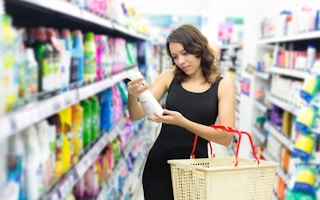Since the end of World War II, our planet has undergone massive human-influenced environmental change, unnoticed by most. A few decades ago, chemistry was the new frontier for corporations and consumers. New technologies offered stability, convenience, entertainment, innovation, luxuries and, maybe most importantly, control. Molecules never before in existence provided us with cutting-edge breakthroughs.
So, in the U.S., we flooded the market, the environment and ourselves with approximately 60,000 synthetic industrial chemicals before the government decided that it needed to take action. The U.S. Environmental Protection Agency attempted to regulate toxic substances in 1976, but most of the chemicals in use were deemed safe, with very little safety testing. The logic at the time was that with any chemical, “the dose makes the poison,” and exceedingly small amounts would not have much, if any, effect.
“There was this idea that our exposures to chemicals in the tiny amounts that we really do experience in consumer products, would not be enough to matter,” Devra Davis, founder and president of Environmental Health Trust, told me when I interviewed her for the documentary film I made on these matters, “Unacceptable Levels.” “But what we’re learning now is that really tiny, tiny amounts of certain chemicals, because of how they are able to trick our own hormone system, can really have disastrous effects at very low levels of exposure.”
The Numbers
Today, chemicals comprise the backbone of our modern lifestyle and are the largest sector of our economy. We generate 300 billion pounds of synthetic chemicals each year in the U.S. alone, and an average American uses more than 1,500 pounds of chemical products.
After all of the growth and change we have experienced in the last 70 years, this much is clear: We still have very little idea what those chemicals do to our bodies in small doses, one chemical at a time. And with studies now showing that more than 232 synthetic industrial chemicals have been detected in newborn babies and 486 in people of all ages, how can we know how those individual chemicals interact with each other inside of our bodies?
“You’re never just exposed to one chemical at a time,” Davis said. “Life is a mixture — we live in a sea of chemicals today. And although the levels are extremely low, they add up. And what we know is it’s the sum total, the cumulative effect of the steady accumulation of these things over time that we have to pay attention to.”
In the U.S., an estimated 10,000 to 20,000 farmworkers are poisoned due to pesticide exposure every year. Fifty percent of men and one in every three women will get cancer. One in every 68 children will have autism. Health care costs are estimated to be $3.1 trillion in 2014 in the U.S. alone — a huge portion of the gross domestic product.
Through my interviews I learned these and other staggering statistics, and came to the conclusion that our bodies are being poisoned very slowly every day of our lives from conception.
“Looking at the prevalence numbers in autism, we’ve gone from 1 in 10,000 to 1 in 110. … That’s not genetics alone,” Jeff Sell, former vice-president of the Autism Society of America, told me.
Andy Igrejas, national campaign director for Safer Chemicals, Healthy Families, called our bodies “ground zero in the battle over pollution.”
“That’s the fundamental change that’s happened,” he told me. “And it is related to the diseases in this country. That’s what makes this an urgent issue.”
And, we’re all willfully allowing this to take place through the products we use and the environments we live in.
“When we’re dealing with chemicals in the environment [we’re never going to have] the kind of evidence that we would have, for example, on a drug trial, where we give people specific doses of a chemical or specific doses of a drug and then look to see how it’s effective or whether it has side effects,” said Joel Tickner, a member of the community health and sustainability faculty at the University of Massachusetts Lowell. “[Yet] we often misinterpret the lack of proof of harm as evidence of safety.”
As strong as they are at detoxing, our bodies are not able to keep up with this deluge of ingesting, inhaling or absorbing toxic chemicals every day. When we learn that babies are born pre-polluted, we must recognize that action — with both our voices and our wallets — needs to be taken.
Next Steps
“
These issues affect all of us, regardless of race, gender or social class. Without help from corporations, courts and the government, buying our way out of this problem is not realistic, but we can still take action for our health and the health of future generations.
These issues affect all of us, regardless of race, gender or social class. Without help from corporations, courts and the government, buying our way out of this problem is not realistic, but we can still take action for our health and the health of future generations. Like many environmental issues, this can feel overwhelming, but information opens the door to changed behavior, advocacy and activism. We all need to learn as much as we can, make intentional buying decisions and take action for safer products. That means, first and foremost, reading labels and finding out more about the ingredients that are ubiquitous in the products we interact with every day.
It has taken almost seven decades to reach this point, and it may take as long to back ourselves out of it. But if we wait for our politicians, lobbyists and manufacturers to get in line with our wishes, it could take even longer.
We face many problems in our modern world, and it often feels easier to accept fate and just retreat to the television with a bag of chips and ignore it all. But, if we’ve learned anything from social movements of the past where large-scale change has taken place, it’s this: If we face problems collectively, we are much stronger than if we approach them in isolation. “It’s going to take a very different way of constructing the laws and policies that govern [the chemical] industry to drive interest away from investment in toxic substances,” Michael Wilson, former director of the Labor Occupational Health Program at the University of California, Berkeley, told me.
This is one of the biggest problems we have ever faced. If we don’t figure it out soon — for ourselves and future generations — it’s hard to say where we’ll be seven decades from now. A future where developing cancer is pretty much a given or where half our children fall somewhere on the autism spectrum is not hard to imagine. Jamie Page, chief executive at the Cancer Prevention and Education Society, told me, “There’s no point in trying to develop treatments for diseases like cancer if we don’t look at causes.”
The good news is, each of us can take steps to reduce the amount of chemicals we’re exposed to daily. Here are five tips:
- Read food labels. If you can’t pronounce an ingredient, chances are you shouldn’t be eating it.
- Purchase organic food whenever possible. Factor in the potential health costs of processed, pesticide-rich foods, and organic food doesn’t break the bank. If we vote with our dollars, organic can become the norm.
- Switch to nontoxic, biodegradable laundry and cleaning products. This is an easy way to create a safer, healthier home environment for you, your family and your pets. There are many choices out there today.
- Transition to nontoxic personal care products. Skin is the body’s largest organ. Say no to triclocarban, triclosan, parabens, retinyl palmitate, retinol, PEGS, ceteareths, polyethylene.
- Reuse, reduce, recycle. Our planet is inundated with plastic products and waste. In one way or another, as the top of the food chain, we’re going to end up ingesting them. Look for products with less packaging; think twice about upgrading to a new phone; bring reusable bags to the grocery store. It can be that simple.
If we do nothing, nothing will get better. But if we take the time to learn more about these issues and if we act collectively through our purchases and pressure our leaders to create policies that will protect us and future generations, maybe we can create a future free of the chemical body burden we face today.
“The difference between a chance and no chance, the difference between some hope and no hope,” toxic chemical litigator Amanda Hawes told me, “is a huge difference.”
Ed Brown is a self-taught filmmaker. This post originally appeared on Ensia.











